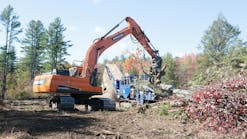I recently read about buildings from ancient Persia called yakhchāls, which were an early form of refrigeration. The yakchāls’ beehive shape encouraged hot air to leave through a hole in the top, and holes near the bottom encouraged the flow of cool air, keeping the vast underground portion of the structure cold. One of the most important design features, however, was the insulating walls. They were made of a clay, egg white, goat-hair, lime, and ash mixture that was both waterproof and heat resistant. Even still, to keep the ice inside yakchāls frozen all summer, the walls had to be at least 2 meters thick at the base. I don’t envy the workers who had to build those foundations.
While we might marvel these ancient structures that allowed the Persians to both store food and make delicious frozen desserts in the hot summer months, insulation technology has come a long way in the last 2400 years. Modern builders can choose from a wide array of insulating options including spray foam, rock wool, fiberglass, or polystyrene. There are even bricks that have insulation like perlite inside them, further reducing the thickness of walls. Recently, however, scientists at Empa, a Swiss research group, developed a brick with built-in insulation they think will blow the other competitors out of the water, the American Society of Mechanical Engineers reports.
These bricks, called aerobricks, are filled with the super lightweight material aerogel. Aerogel has been around since 1931 and has a host of other applications, perhaps the most famous of which is NASA’s use of aerogel to insulate astronauts’ space suits. In aerogel, gas replaces the liquid traditionally used to make gels. Tiny nano-bubbles inhibit the movement of air through the gel, making it an excellent insulator. Unfortunately, the kind of aerogel NASA uses wouldn’t work with the bricks, so the researchers created a paste of aerogel particles to fill the bricks.
The results were remarkable. A conventional brick wall would need to be more than 6 feet thick to insulate as well as an aerobrick. To compete with aerobricks in terms of insulating power, perlite-filled bricks need to be 35% thicker. Because aerogel is made with gas rather than liquid, it is also incredibly light, making installation much easier and, as if that wasn’t enough, it absorbs almost no moisture and is recyclable, nontoxic, and non-flammable.
Before you rush out to buy a pallet of aerobricks, however, there’s one pretty big downside. Currently, only two companies manufacture aerogel and as such, using aerobricks would add a whopping $550 in cost per 3 square feet of wall. Researchers are hoping that price will drop as the production process is simplified. In December 2016, Empa reported that one of their research teams had developed and patented an aerogel production method that cut production time by over half. The team is currently working on scaling up their method and hopes to be able to produce aerogel on an industrial level by 2020.
Good insulation needs no promotion; we can all get behind lower heating and cooling bills. There are even several benefits to including insulation in bricks. In extremely hot or cold climates, getting good insulation without walls several feet thick is a much more efficient use of space. Pre-insulated bricks could also allow historical buildings to increase energy efficiency without affecting the look of the building. And for the construction industry, built-in insulation could mean shorter project times and easier installation, especially with lightweight aerobricks.
What about the dirt moving industry? While it’s unlikely that researchers will find a way to make dirt any lighter, perhaps someday contractors will be pouring aerogel-infused concrete for foundations. Maybe researchers will use aerogel to create super-lightweight materials for bridges and roads. As scientists develop new and innovative forms of concrete, asphalt, steel, and so on, the kinds of equipment the dirt moving industry uses may change. What will today’s building techniques look like to the dirt movers of the future?
Although we won’t see aerobricks or any other aero-inspired materials at our local construction sites for a while, we can at least be thankful we’re no longer building 2-meter-thick walls and foundations of goat hair and egg whites.



